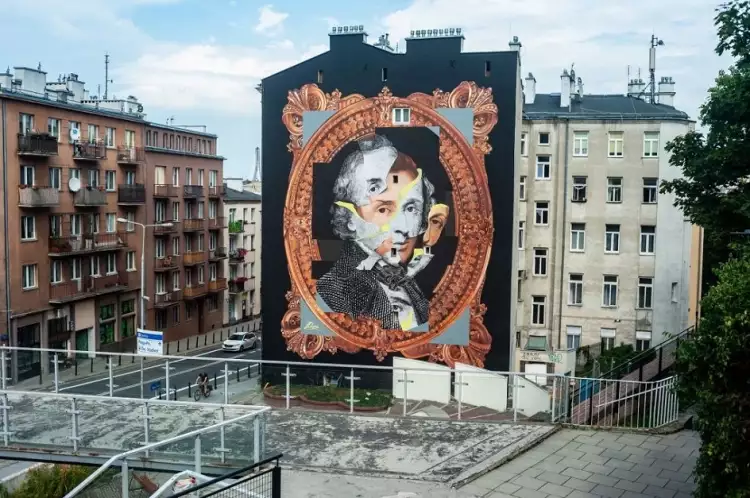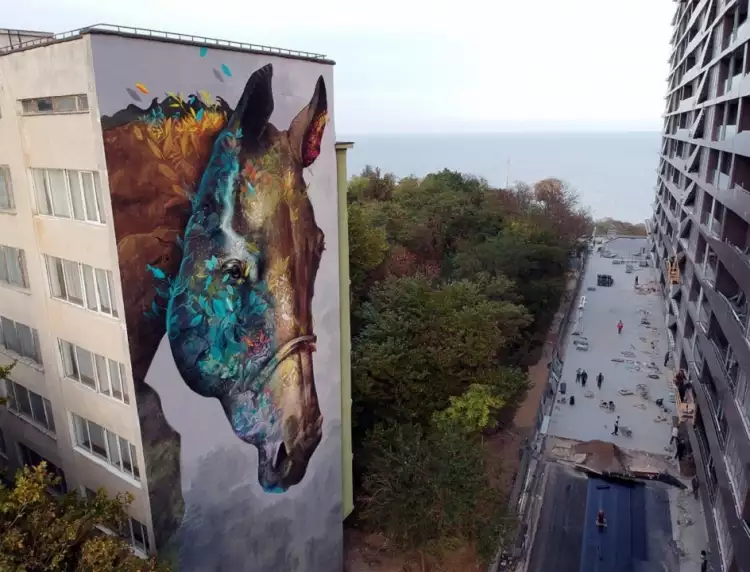A mural is a type of monumental painting on large buildings and other architectural structures. Murals typically consist of colorful, expressive images painted on the vertical surfaces of residential buildings, commercial properties, or fences. Less frequently, artists work on the interior spaces of large buildings, such as lobbies, halls, or high-rise building atriums.
 Mural. Mural Mona Lisa Draws Leonardo da Vinci in São Paulo
Mural. Mural Mona Lisa Draws Leonardo da Vinci in São Paulo
Mural art is in high demand in today's urban environments, especially in large cities. Authorities in major metropolises readily provide artists with large vertical surfaces for painting. Beautiful murals stand out against the uniform urban landscape and attract tourists from all corners of the Earth.
 Mural. Mural Mona Lisa Draws Leonardo da Vinci in São Paulo
Mural. Mural Mona Lisa Draws Leonardo da Vinci in São Paulo
Classification and features of murals
A mural is a unique form of monumental painting that exhibits elements of both traditional frescoes and contemporary street art. Large-scale artworks created by skilled artists can vary in terms of:
- Theme.
- Technique.
- Type of paint.
- Genre.
- Style.
 Mural. Mural Mona Lisa Draws Leonardo da Vinci in São Paulo
Mural. Mural Mona Lisa Draws Leonardo da Vinci in São Paulo
Among the diverse mural themes popular in most countries worldwide, the following are of the highest interest:
- Social. Addresses contemporary societal issues, evokes empathy in viewers, and encourages them to help the heroes of the artwork.
- Patriotic. Part of official state propaganda, used by authorities to glorify the country and outstanding historical figures.
- Philosophical. Serves as a means for artists to express their individual creative ideas, provoking strong emotions in the audience.
- Aesthetic. Ideal for enhancing the visual appeal of urban spaces, with a neutral emotional tone.
- Religious. Celebrates the greatness of God and encourages reflection on eternal spiritual values.
 Mural. An abstract style mural in Toronto
Mural. An abstract style mural in Toronto
Murals, like regular urban graffiti, are created using several different painting techniques. The main tools for applying images to the wall include:
- Spray paint cans.
- Rollers.
- Brushes.
- Pre-prepared stencils.
 Mural. Mural in New York's Brooklyn neighbourhood
Mural. Mural in New York's Brooklyn neighbourhood
Differing from other forms of street art, murals are distinguished not only by their large dimensions but also by three other important features:
- First, the creation of a large-scale work of art requires significant efforts and artistic materials, leading to the need to seek and engage affluent patrons in the project's realization.
- Second, the artist must obtain permission from city authorities and/or the building owner before commencing work. Ignoring this rule can result in unpleasant consequences, including financial fines.
- Third, mural artists often work on commissions from curators or sponsors and receive substantial financial rewards for their work. The initiative to create monumental works of art typically comes from the top down.
 Mural. A mural in Rome mocking the age of consumerism
Mural. A mural in Rome mocking the age of consumerism
History of Murals
The history of murals as an independent form of monumental art dates back approximately 100 years. Although people have been fascinated with the artistic painting of vertical walls with grand scenes on the themes of hunting and sacrifices since prehistoric times, numerous examples of such creativity have survived to the present day in caves around the world.
 Mural. Mural «Lichbavy Svet» in Gomel
Mural. Mural «Lichbavy Svet» in Gomel
The birthplace of the modern mural is rightfully considered to be Mexico. It was in this Latin American country that a new form of monumental art emerged during the revolutionary events of the 1920s. Local artists literally embraced the call of avant-garde artists to step out of the workshop onto the streets, to bring revolutionary art to the masses, and ruthlessly break classical traditions.
 Mural. Mural «Lichbavy Svet» in Gomel
Mural. Mural «Lichbavy Svet» in Gomel
One of the first to engage in mural painting was the eminent Mexican painter José Clemente Orozco. In 1923, he created a massive artistic image on the wall of the National Preparatory School in Mexico City.
 Mural. Coronavirus-themed mural in Mexico City
Mural. Coronavirus-themed mural in Mexico City
The new approach to monumental art was favorably received by the authorities of Mexico. The Minister of Education even commissioned a group of young revolutionary artists to paint a series of murals on public buildings. Many artists who later became widely renowned participated in this task:
- Diego Rivera.
- David Alfaro Siqueiros.
- Rufino Tamayo.
- Miguel Covarrubias.
- Jean Charlot.
 Mural. Coronavirus-themed mural in Mexico City
Mural. Coronavirus-themed mural in Mexico City
Many of the artists mentioned above were communists by conviction. They brought revolutionary creative ideas to the Soviet Union in the 1930s, where the authorities later extensively used large wall paintings to propagate socialist ideals.
 Mural. Mural Conquerors of Sky and Space in St. Petersburg
Mural. Mural Conquerors of Sky and Space in St. Petersburg
In Western European countries and the United States, the art of murals began to gain popularity much later, in the mid-1980s. During those times, graffiti was a major issue in large cities. Street artists ruthlessly covered the walls of buildings, fences, and even subway cars with spray paint. Local authorities unsuccessfully battled artistic vandalism for decades.
One of the solutions to this pressing problem was the promotion of murals, gradually adopted in most major metropolises. Its implementation not only significantly reduced the amount of graffiti but also provided extensive opportunities for young artists to express themselves.
 Mural. A mural depicting Frederic Chopin in Warsaw
Mural. A mural depicting Frederic Chopin in Warsaw
Today, murals occupy a significant place in global culture. They play an important role in shaping a comfortable urban environment, attract tourists, and serve as an excellent means of self-expression for talented painters.
 Mural. A mural depicting Frederic Chopin in Warsaw
Mural. A mural depicting Frederic Chopin in Warsaw
On the Very Important Lot portal, every visitor can participate in art auctions and acquire antique masterpieces. Our website also offers an excellent opportunity for anyone to directly purchase paintings from talented contemporary artists from different countries.


 The coin of 37 rubles and 50 kopecks is a valuable masterpiece of Russian numismatics with a non-standard denomination
The coin of 37 rubles and 50 kopecks is a valuable masterpiece of Russian numismatics with a non-standard denomination  Five centuries of antique and modern firearms
Five centuries of antique and modern firearms  The engraving "Rhinoceros" by Albrecht Dürer - Europe's acquaintance with a curious beast
The engraving "Rhinoceros" by Albrecht Dürer - Europe's acquaintance with a curious beast  Realism - the art of portraying life in all its manifestations truthfully
Realism - the art of portraying life in all its manifestations truthfully  Armand was a brilliant French artist who timely abandoned his career as a painter to later become a globally renowned sculptor
Armand was a brilliant French artist who timely abandoned his career as a painter to later become a globally renowned sculptor  Marble Veil: Trompe-l'oeil Technique in Sculpture
Marble Veil: Trompe-l'oeil Technique in Sculpture  Renaissance is an era of great names
Renaissance is an era of great names  Mannerism - an elegant, pretentious, and ambiguous style of the 16th and 17th centuries
Mannerism - an elegant, pretentious, and ambiguous style of the 16th and 17th centuries  Symbolism: the essence of the term, history in painting, distinctive features, famous symbolists
Symbolism: the essence of the term, history in painting, distinctive features, famous symbolists  Photography is an art accessible to everyone
Photography is an art accessible to everyone